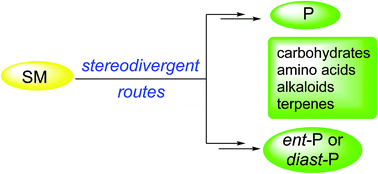Stereodivergent routes in organic synthesis: carbohydrates, amino acids, alkaloids and terpenes
Abstract
The natural occurrence of enantiomers and diastereomers is often encountered. In addition, the synthesis of these stereoisomers is important for structure determination and for the study of structure–activity relationships. Stereodivergent routes simplify the access to these molecules starting from a common material. This review is focused on the synthesis of carbohydrates, amino acids, alkaloids and terpenes using this efficient strategy. In the case of carbohydrates, such as monosaccharides, carbasugars, aminosugars and azasugars, carbohydrates are usually employed as common starting materials. As a very common strategy, configurations of hydroxy groups are inverted by SN2 methods playing with protection and deprotection processes. For the synthesis of acyclic α-AAs, diastereoselective methods using mainly Garner's aldehyde have been described. Diastereodivergent routes allowed the synthesis of β-hydroxy- and β-amino-α-amino acids, as well as of β- and γ-amino acids. Heterocyclic and cyclic amino phosphonic acids were synthesized using diastereodivergent routes. Alkaloids containing five- and six-membered saturated azaheterocycles needed multistep stereodivergent routes and other alkaloids, such as enantiomers of balanol, vincamine, anatoxin and codeine, and diastereomeric isochaetominines C and galanthamines. In the terpene field, sesquiterpenes β-santalene, α-curcumene and α-cuparenone and the diterpene scopadulcic acid A have been synthesized using enantiodivergent routes.



 Please wait while we load your content...
Please wait while we load your content...